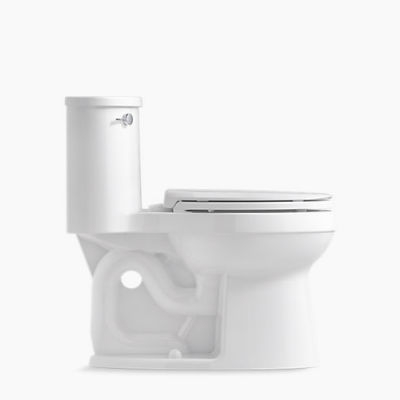We’ve come a long way in terms of designing bathrooms. These days style plays more of a role than ever before, not only in the decor of the bathroom but in the appliances, too. A variety of toilets are now available to homeowners, one of those being the exposed trapway toilet. Let’s explore this toilet type to help you decide if this is the style that you should go for.
What Is a Trapway Anyway?
To start, it helps to know what a trapway is. A trapway is one of the most crucial elements of any toilet. It greatly reduces the chances of clogs and creates a smooth passageway for wastewater to get to the local sewage line.
The trapway is an S-shaped pipe that snakes out of the back of the toilet, where you see the wastewater flushed away. From there, it does an S-bend to siphon the water out of the toilet and into your home’s drainage and plumbing system. Most toilets in American homes have a concealed, or partially concealed, trapway. That is, you can’t see the S-pipe running along the side of the toilet because it is boxed in. Whether it is exposed or not is up to you, as it is purely an aesthetic choice.
The Look of an Exposed Trapway Toilet
An exposed trapway can add visual appeal, especially in a bathroom where there isn’t a whole lot going on. The look is interesting and can be something out of the ordinary. An exposed trapway still looks sleek and modern, especially since caps cover the bolts that screw the toilet into the floor. This can create a streamlined look consistent with the rest of your bathroom.
Exposed Trapway Considerations
Our exposed trapway toilet reviews are pretty comprehensive but let’s highlight some of the main points here. One of the things to keep in mind with an exposed trapway toilet is that it can be difficult to clean. A concealed trapway toilet will have a smooth side where the trapway is hidden, so it’s quite easy to wipe down and clean. On the other hand, an exposed trapway means there are more curves and angles, plus it is located behind the bowl. This means you will need to be diligent if you want to keep your toilet completely clean.
Another thing to be aware of is the size of the trapway, as it will affect the performance level of your toilet. The American National Standards Institute sets forth the minimum size requirement for trapways, which is currently at 1.5 inches. Many toilet manufacturers opt for toilet trapways between 1.75 and two inches. This helps to ensure higher flushing performance and peace of mind for homeowners.
You might assume that the larger the trapway size, the better. However, this isn’t always the case, since the extra space might result in less force pushing the wastewater out. That could mean a toilet with weaker flushes and a higher likelihood of needing to be plunged.
While shopping around, you might notice that some manufacturers mention that the trapways on their toilets are “fully glazed.” It sounds great, but it doesn’t mean much to experts. It simply means that the pipe has been covered in a glaze to help move things along. Some professionals prefer more roughness to their trapways, so you shouldn’t get worked up about it.
How Much Does an Exposed Trapway Toilet Cost?
Finally, let’s address price, which is perhaps the most important component for any homeowner. The good news is that an exposed trapway toilet should cost around the same amount as a concealed trapway toilet. Moreover, you can find both one-piece and two-piece toilets with exposed trapways, so you have a wealth of options available.
Keep in mind that the trapway is just one small part of the overall buying process. Yes, trapways are critical since they connect the toilet bowl to your sewer line. However, you also need to focus on other aspects, such as seat height and shape, flushing capabilities, and rough-in size. It can be a lot to think about, but some professionals online and at your local home improvement store would love to help.
Now that you know more about trapways and that they perform the same whether concealed or exposed, you can carry on with your decision-making process.

